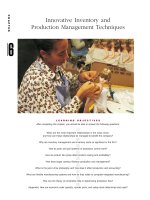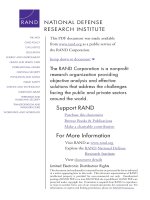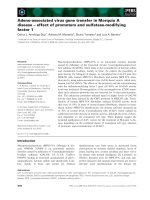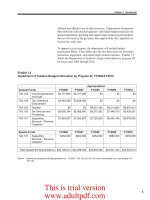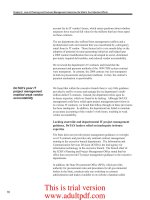Lecture Principle of inventory and material management - Lecture 1: Course Introduction
Bạn đang xem bản rút gọn của tài liệu. Xem và tải ngay bản đầy đủ của tài liệu tại đây (443.37 KB, 30 trang )
Principle of Inventory and
Material Management
LSM736
Lecture 1
Course Introduction
What Will We Do Today?
•
•
•
How is this course organized?
What is Inventory and Material Management
Management?
A Historical Perspective
What is Operations Management?
•
Business strategy
– selecting market(s) to compete
– level of investment
– allocation of resources
– functional area strategy
•
•
•
marketing
finance
production and operations
What is Operations Management?
Operations Management = Strategy
Execution
Time
Quality
Flexibility
Cost
OM = Designing, operating, and improving
the systems that deliver
the firm’s primary products and services
Strategy Execution
1. What is our strategy?
2. How do we design our operations to support it?
Product / Service
Development
Process Design and
Management
Supply Chain
Management
What types of problems does OM address ?
Example #1: Manufacturing Supply Chain Management
T3
T2
T3
T1
W
T3
T3
C
.com
C
R
C
OEM
T2
T1
T3
T2
C
W
R
C
What types of problems does OM address ?
Example #2: Bank Services
Loans
Deposits
Credit
Cards
What types of problems does OM address ?
Example #3: R&D – New Product Development
Phase
0
Planning
Phase
Concept
1
Development
Phase
System-level
2
Design
Phase
Detail
Design
3
Phase
Testing
and
4
Refinement
Phase
Production
5
Ramp-Up
Adapted from U&E
2002
Types of Decisions in OM …
•
Strategic decisions (longterm impact)
•
Tactical decisions (midterm impact)
•
Operational decisions (shortterm impact)
Strategic Decisions …
Strategic questions that operations
managers ask and respond to …
1.
How much capacity do we need?
Manufacturing
2.
How should our staff be trained?
Services
3.
Which projects should we invest in?
Prod. Development
Tactical Decisions …
Tactical questions that operations
managers ask and respond to …
1.
2.
3.
Should we have finished goods
inventory or should we maketoorder?
What types of queues should we employ
in Hartsfield?
Do we need to exchange preliminary
information with mfg?
Manufacturing
Services
Prod. Development
Operational Decisions …
Operational questions that operations
managers ask and respond to …
1.
2.
3.
Which product gets priority in front
of machine A?
Manufacturing
Should the service system be FCFS
or something else?
Services
What is the critical path of the
project?
Prod. Development
Goal of Operations Management
What is the goal of OM with respect to production/service
systems?
1.
Improving efficiency
2.
Improving effectiveness
3.
Increasing value
Efficiency is doing something at the
lowest possible cost
Effectiveness is doing appropriate
things to create value for the
organization
Value = “quality” / “price”
Usually, these things require a tradeoff.
Value Added of Operations Management
Adverse Financial Impact of Supply Chain Disruptions
•
Study of 800 publicly traded firms over a 10year period
•
In the year leading up to disruption
• 107 percent drop in operating income
• 114 percent drop in return on sales
• 93 percent drop in return on assets
• 7 percent lower sales growth
• 11 percent growth in cost
• 14 percent growth in inventories
•
•
•
33 – 40% lower stock returns relative to industry
benchmark in period starting 1 year before and 2 years
after the disruption
Share price volatility is 13.5% higher in the year after the
disruption
Hendricks and Singhal, “The Effect of Supply Chain Disruptions on
Longterm Shareholder Value, Profitability, and Share Price Volatility
Value Added of Operations Management
•
Reasons:
–
–
–
•
31% internal (equipment breakdown, manufacturing problems,
quality problems, inaccurate inventory records, poor
forecasting, capacity or labor shortages)
14.5% supplier failures
12.8% customers
Part shortages:
•
•
Underperformance by 25%
Median decrease in operating income of 31%
Hendricks and Singhal, “The Effect of Supply Chain Disruptions on
Longterm Shareholder Value, Profitability, and Share Price Volatility
What are Operations Management Jobs Like?
You can get an interesting job!!
Supply Chain Manager
Quality Manager
Project Manager
Operations Consultant
Plant Manager
Procurement Manager
The OM Area at Tech is ranked in the top 10 in the US and
employers take it seriously!
A Historical Perspective
The First Industrial Revolution (c. 1850)
•
Textile manufacturing innovations
“Flying shuttle” and “Spinning Jenny”
J. Watt: The steam engine
Substituting labor with machines
•
•
small scale
production
A. Smith: Free markets – division of labor
Free markets would enhance “quest” for profit
Specialization could increase productivity
The American System of Manufacturing
Vertical Integration
Consolidating different operations under one roof
•
Interchangeable parts
Massproduce parts to tight tolerance & assemble
•
1801 contract for 10,000 muskets for the government
•
Unskilled workers
The Second Industrial Revolution (c. 1910)
1832: 36 enterprises in 10 states with > 250 workers
Reliance on water power & local distribution system
•
•
•
•
Transportation innovations
Railroads are built in western world
large scale
production
Communication innovations
The telegraph is established
Big retailers come to power
Sears & Roebuck’s sales soar to $38M in 10 years
Mass Production: the first vehicles arrive…
Henry Ford starts producing Model T
•
19101920: The Scientific Method (Taylorism)
•
•
•
•
Principles of Scientific Management
Book published in 1911 by Fredrick Taylor
Time and Motion studies
How much time do workers need to do a task?
Incentive systems
What is the best payment scheme?
Efficiency is
the key!
Study how systems can be efficient
Developed a set of principles that serve efficiency.
Planning versus doing.
1920’s 1930’s: Taylorism Spreads
•
Application of Taylor’s methods
The DuPont Powder company
More importance to the human element
Studies at the Western Electric Hawthorne plant to
understand ergonomics: the human element in
manufacturing
•
•
Investment in management education
Between 1914 and 1940 Bschools grew a lot
1940’s 1960’s: The Golden Era in the U.S.
•
•
Operations Research tools are “born”
G.B. Dantzig devises simplex algorithm
Effort to study complex systems
The importance of teamwork is introduced
Mathematical analysis becomes the norm
Scientific methods are applied throughout the
organization
•
Mathematics solidify the scientific method
Simulation based models, computer usage,
scheduling
•
1970’s: Computers and MRP take over
Production
Schedule
Bill of
materials
Inventory
status
Forecasted
Demand
MRP
(Materials
Requirement
Planning)
MRP automated production…
But, someone has to tell the computers what to analyze!
